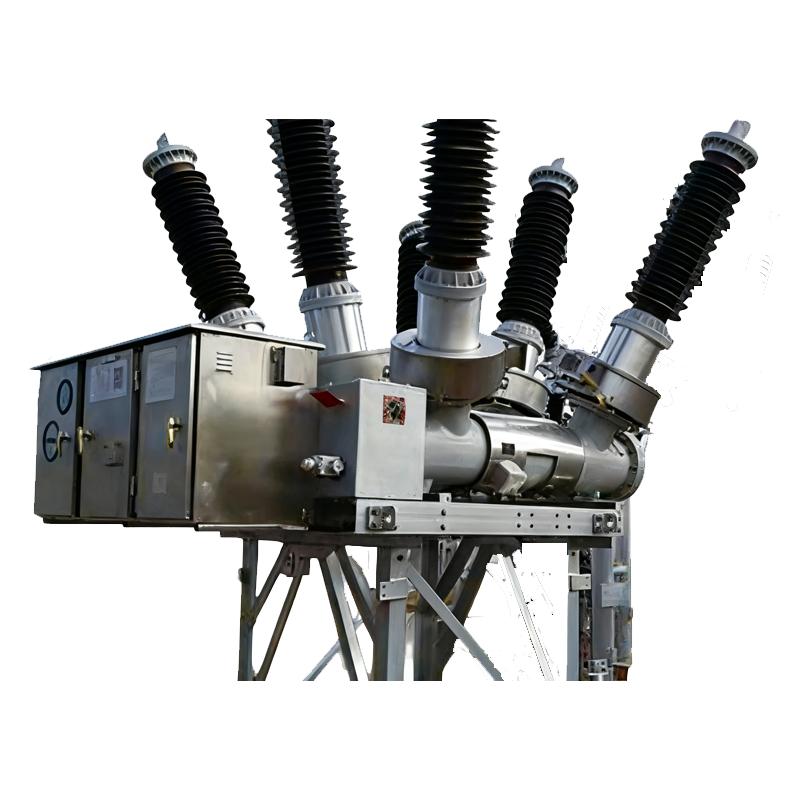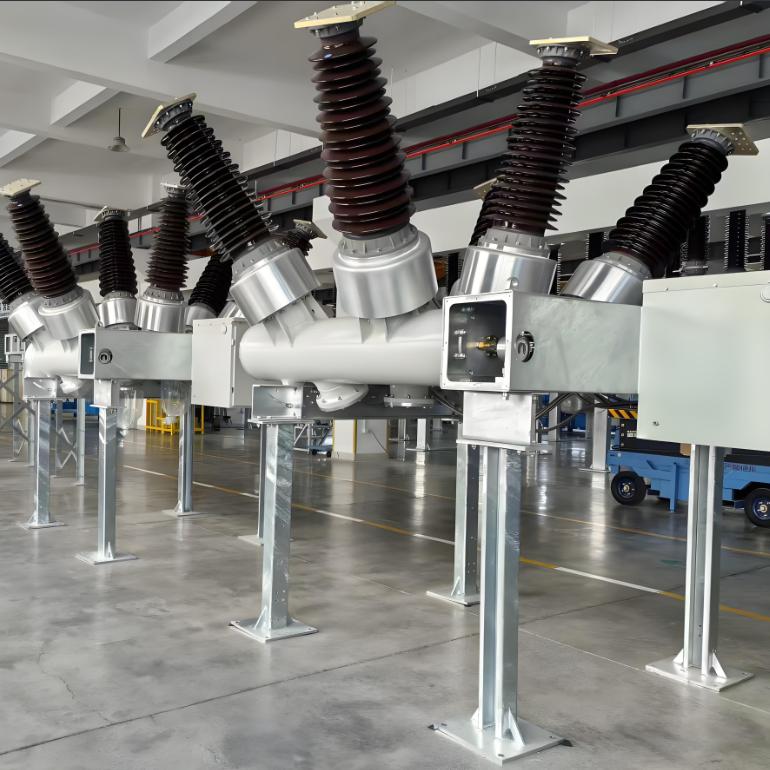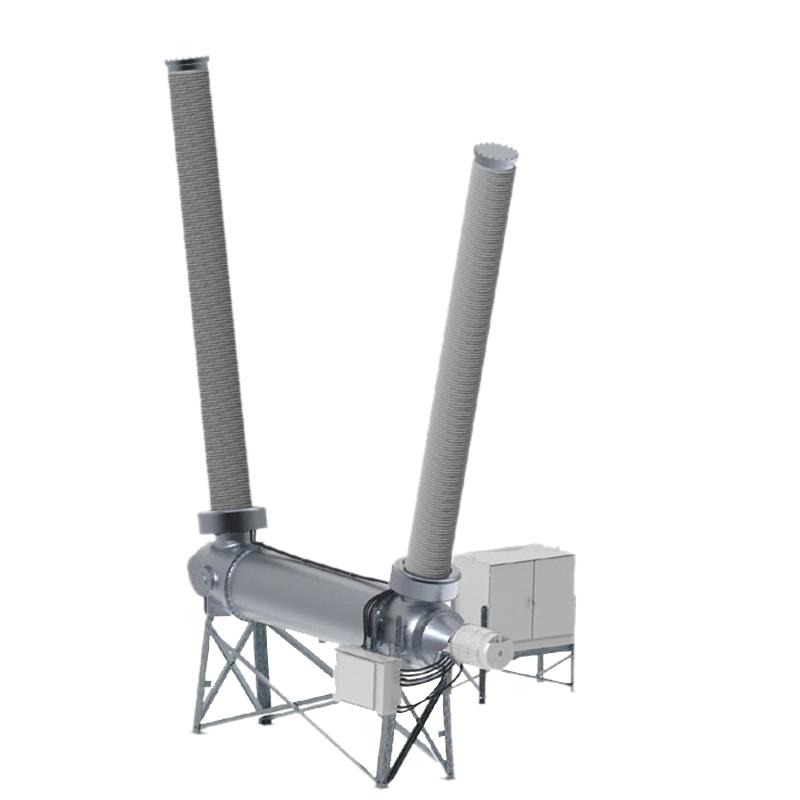| Brand | ROCKWILL |
| Model NO. | 800kV dead tank SF6 circuit breaker |
| Rated voltage | 800kV |
| Rated normal current | 5000A |
| Rated frequency | 50/60Hz |
| Series | LW |
Description
800kV Dead Tank SF6 Circuit Breaker is a high-performance ultra-high voltage device designed for critical power transmission systems. Featuring a robust dead tank structure, its live components are sealed in an SF6 gas-insulated metal casing, delivering superior arc extinction efficiency (100x faster than air) and dielectric strength (2-3x air’s at 1atm) to rapidly interrupt fault currents and ensure grid stability. The low-center-of-gravity design enhances seismic resistance, adapting to extreme climates and rugged terrains. Integrated with bushings and current transformers, it supports multi-function control for real-time measurement and protective switching. With a mechanical/electrical lifespan exceeding 30 years and a fully sealed design, maintenance frequency is minimized, cutting operational costs. Equipped with anti-misoperation interlocks and dual-insulation safeguards, it prioritizes personnel safety and system reliability. Ideal for UHV grids, power plants, and industrial applications, this breaker sets a benchmark for efficiency and durability in 800kV high-stress environments.
Main Features
Technical specifications


The leakage rate of SF₆ gas must be controlled at an extremely low level, typically not exceeding 1% per year. SF₆ gas is a potent greenhouse gas, with a greenhouse effect 23,900 times that of carbon dioxide. If a leak occurs, it can not only cause environmental pollution but also lead to a decrease in the gas pressure within the arc quenching chamber, affecting the performance and reliability of the circuit breaker.
To monitor the leakage of SF₆ gas, gas leakage detection devices are typically installed on tank-type circuit breakers. These devices help to promptly identify any leaks so that appropriate measures can be taken to address the issue.
1. Select the circuit breaker corresponding to the voltage level based on the power grid level
The standard voltage (12/24/40.5/72.5/126/170/245/363/420/550/800/1100kV) is matched with the corresponding nominal voltage of the power grid. For example, for a 35kV power grid, a 40.5kV circuit breaker is selected. According to standards such as GB/T 1984/IEC 62271-100, the rated voltage is ensured to be ≥ the maximum operating voltage of the power grid.
2. Applicable scenarios for non-standard customized voltage
Non standard customized voltage (11/22/44/52/132/230/275/300/345/400/380/765kV) is used for special power grids, such as the renovation of old power grids and specific industrial power scenarios. Due to the lack of suitable standard voltage, manufacturers need to customize according to power grid parameters, and after customization, insulation and arc extinguishing performance must be verified.
3. The consequences of selecting the wrong voltage level
Choosing a low voltage level can cause insulation breakdown, leading to SF leakage and equipment damage; Choosing a high voltage level significantly increases costs, increases operational difficulties, and may also result in performance mismatch issues.
-
 Design Solution of 24kV Dry Air Insulated Ring Main UnitThe combination of Solid Insulation Assist + Dry Air Insulation represents the development direction for 24kV RMUs. By balancing insulation requirements with compactness and employing solid auxiliary insulation, insulation tests can be passed without significantly increasing phase-to-phase and phase-to-ground dimensions. Encapsulating the pole column solidifies the insulation for the vacuum interrupter and its connecting conductors.Maintaining the 24kV outgoing busbar phase spacing at 110mm,Rockwill16/08-2025
Design Solution of 24kV Dry Air Insulated Ring Main UnitThe combination of Solid Insulation Assist + Dry Air Insulation represents the development direction for 24kV RMUs. By balancing insulation requirements with compactness and employing solid auxiliary insulation, insulation tests can be passed without significantly increasing phase-to-phase and phase-to-ground dimensions. Encapsulating the pole column solidifies the insulation for the vacuum interrupter and its connecting conductors.Maintaining the 24kV outgoing busbar phase spacing at 110mm,Rockwill16/08-2025 -
 Optimization Design Scheme for the 12kV Air-Insulated Ring Main Unit Isolating Gap to Reduce Breakdown Discharge ProbabilityWith the rapid development of the power industry, the ecological concept of low-carbon, energy-saving, and environmental protection has been deeply integrated into the design and manufacturing of power supply and distribution electrical products. The Ring Main Unit (RMU) is a key electrical device in distribution networks. Safety, environmental protection, operational reliability, energy efficiency, and economy are inevitable trends in its development. Traditional RMUs are primarily representedRockwill16/08-2025
Optimization Design Scheme for the 12kV Air-Insulated Ring Main Unit Isolating Gap to Reduce Breakdown Discharge ProbabilityWith the rapid development of the power industry, the ecological concept of low-carbon, energy-saving, and environmental protection has been deeply integrated into the design and manufacturing of power supply and distribution electrical products. The Ring Main Unit (RMU) is a key electrical device in distribution networks. Safety, environmental protection, operational reliability, energy efficiency, and economy are inevitable trends in its development. Traditional RMUs are primarily representedRockwill16/08-2025 -
 Analysis of Common Problems in 10kV Gas-Insulated Ring Main Units (RMUs)Introduction:10kV gas-insulated RMUs are widely used due to their numerous advantages, such as being fully enclosed, possessing high insulation performance, requiring no maintenance, having a compact size, and offering flexible and convenient installation. At this stage, they have gradually become a critical node in urban distribution network ring-main power supply and play a significant role in the power distribution system. Problems within gas-insulated RMUs can severely impact the entire diRockwill16/08-2025
Analysis of Common Problems in 10kV Gas-Insulated Ring Main Units (RMUs)Introduction:10kV gas-insulated RMUs are widely used due to their numerous advantages, such as being fully enclosed, possessing high insulation performance, requiring no maintenance, having a compact size, and offering flexible and convenient installation. At this stage, they have gradually become a critical node in urban distribution network ring-main power supply and play a significant role in the power distribution system. Problems within gas-insulated RMUs can severely impact the entire diRockwill16/08-2025 -
 SF6-Free Solution for Air-Insulated/Eco-friendly Gas Ring Main UnitsⅠ. Technical Bottlenecks of SF₆ SubstitutionInsulation Medium Performance Gapo Dried Air/N₂ insulation strength is only 1/3 of SF₆, requiring expansion of contact gap from 60mm to ≥150mm.o Conventional spring mechanisms lack energy to drive rapid closure of large gaps, easily causing contact ablation due to pre-strike.o Synthetic gases (e.g., C4+CO₂) decompose under arcing, leading to irreversible insulation degradation.Mechanical Structural Limitationso National Grid standardization fixRockwill16/08-2025
SF6-Free Solution for Air-Insulated/Eco-friendly Gas Ring Main UnitsⅠ. Technical Bottlenecks of SF₆ SubstitutionInsulation Medium Performance Gapo Dried Air/N₂ insulation strength is only 1/3 of SF₆, requiring expansion of contact gap from 60mm to ≥150mm.o Conventional spring mechanisms lack energy to drive rapid closure of large gaps, easily causing contact ablation due to pre-strike.o Synthetic gases (e.g., C4+CO₂) decompose under arcing, leading to irreversible insulation degradation.Mechanical Structural Limitationso National Grid standardization fixRockwill16/08-2025 -
 Implementation Scheme for Installing Lightning Arresters or Voltage Transformers in Gas-Insulated Ring Main UnitsAccording to insulation type, ring main units (RMUs) can be categorized as gas-insulated or air-insulated. The former installs primary circuit components in a sealed metal enclosure filled with low-pressure gas (primarily SF₆ or mixed gases) as the insulating medium, using cable terminals for incoming and outgoing lines. Due to superior insulation, compact size, and modular design, they are widely used in 10kV outdoor distribution substations and prefabricated transformer stations. However, theiRockwill16/08-2025
Implementation Scheme for Installing Lightning Arresters or Voltage Transformers in Gas-Insulated Ring Main UnitsAccording to insulation type, ring main units (RMUs) can be categorized as gas-insulated or air-insulated. The former installs primary circuit components in a sealed metal enclosure filled with low-pressure gas (primarily SF₆ or mixed gases) as the insulating medium, using cable terminals for incoming and outgoing lines. Due to superior insulation, compact size, and modular design, they are widely used in 10kV outdoor distribution substations and prefabricated transformer stations. However, theiRockwill16/08-2025 -
 Pressure Relief Safety Solution for Gas-Insulated Ring Main UnitsⅠ. Problem ContextAs a core component in urban power distribution networks, ring main units (RMUs) are widely used in residential areas, factories, and public buildings due to their compact structure, low cost, and high reliability. However, internal equipment failures or arc faults may generate high-temperature, high-pressure gas, leading to cabinet explosions that endanger personnel and equipment. While traditional sealed designs maintain insulation integrity, they fail to rapidly release sudRockwill16/08-2025
Pressure Relief Safety Solution for Gas-Insulated Ring Main UnitsⅠ. Problem ContextAs a core component in urban power distribution networks, ring main units (RMUs) are widely used in residential areas, factories, and public buildings due to their compact structure, low cost, and high reliability. However, internal equipment failures or arc faults may generate high-temperature, high-pressure gas, leading to cabinet explosions that endanger personnel and equipment. While traditional sealed designs maintain insulation integrity, they fail to rapidly release sudRockwill16/08-2025




















